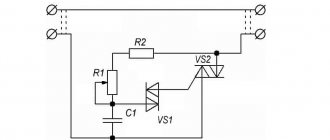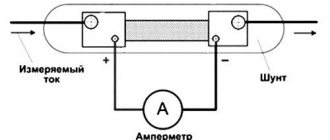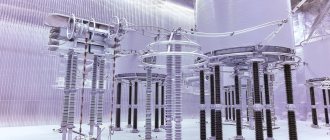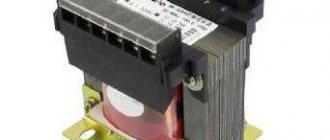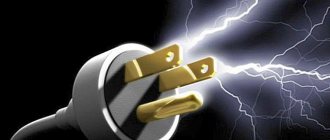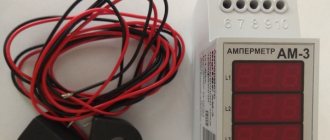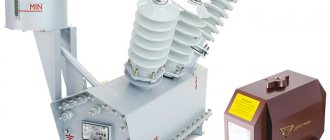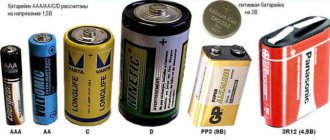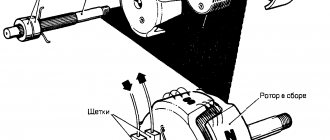Alternating current
(AC - Alternating Current) - an electric current that changes its magnitude and direction over time.
Often in the technical literature, a variable is a current that changes only the magnitude, but does not change the direction, for example, a pulsating current. It must be remembered when making calculations that alternating current in this case is only a component of the total current. This option can be represented as alternating current AC
with a constant
DC
. Or as direct current with an alternating component, depending on which component is most important in the context.
DC
- Direct Current - direct current that does not change its magnitude and direction.
In reality, direct current cannot maintain its value constant, therefore it exists conditionally in those cases where changes in its constant value can be neglected, or as a component ( DC
) for periodically changing electric current of any shape.
Then the DC
will be equal to the average current value for the period, and will be the zero line for the variable component
AC
.
With a sinusoidal current shape, for example in an electrical network, the DC
equal to zero.
Direct current with an alternating component in the form of ripples is shown by the blue line in the upper graph of the figure. AC+DC recording
in this case it is not a mathematical sum, but only indicates two components of the current.
The powers are summed up. The current value will be equal to the square root of the sum of the squares of two quantities - the value of the constant component DC
and the root mean square value of the variable component
AC
.
AC terms
and
DC
are applicable for both current and voltage.
What is alternating (AC) and direct (DC) current?
AC from English “alternating current” means alternating current, and DC “direct current” means direct current.
AC alternates the direction of current, but DC flows in only one direction.
Welding machines and electrodes marked DC have a constant polarity, while those marked AC change polarity 120 times per second with a current frequency of 60 hertz.
Electrical voltage is divided into two types:
- constant (dc)
- variable (ac)
The designation for direct current is (—), for alternating current the designation is (~). The abbreviations ac and dc are well-established and are used along with the names “constant” and “variable”. Now let's look at what is their difference. The fact is that constant voltage flows only in one direction, which is where its name comes from. And a variable, as you already understood, can change its direction. In particular cases, the direction of the variable may remain the same. But, in addition to the direction, its magnitude can also change. In a constant, neither magnitude nor direction changes. The instantaneous value of alternating current is its magnitude, which is taken at a given moment in time.
In Europe and Russia, the accepted frequency is 50 Hz, that is, it changes its direction 50 times per second, while in the USA, the frequency is 60 Hz. Therefore, equipment purchased in the United States and in other countries may burn out with different frequencies. Therefore, when choosing equipment and electrical appliances, you should carefully ensure that the frequency is 50 Hz. The higher the frequency of the current, the greater its resistance. You can also notice that in the sockets in our house it is AC that flows.
In addition, alternating electric current is divided into two more types:
- single-phase
- three-phase
For single-phase, a conductor is required that will conduct voltage and a return conductor. And if we consider a three-phase current generator, it produces an alternating voltage with a frequency of 50 Hz on all three windings. A three-phase system is nothing more than three single-phase electrical circuits, out of phase relative to each other at an angle of 120 degrees. Through its use, it is possible to simultaneously provide energy to three independent networks, using only six wires that are needed for all conductors: forward and reverse, to conduct voltage.
And if you, for example, have only 4 wires, then there will be no problems either. You will only need to connect the return conductors. By combining them, you get a conductor called neutral. It is usually grounded. And the remaining external conductors are briefly designated as L1, L2 and L3.
But there is also a two-phase one, it is a complex of two single-phase currents, in which there is also a direct conductor for conducting voltage and a reverse one, they are shifted in phase relative to each other by 90 degrees.
Voltage formula
There is a formula in physics, although it has no practical application. The official formula is written like this.
voltage formula
Where
A is the work done by the electric field to move a charge along a section of the circuit, Joules
q - charge, Coulomb
U—voltage on a section of the electrical circuit, Volts
In practice, the voltage across a section of a circuit is derived through Ohm's law.
It will be interesting➡ Capacitor charge
voltage from Ohm's law
Where
I - current, Amperes
R - resistance, Ohms
The difference between variable and constant
First of all, DC voltage must be generated at substations with a relatively low voltage to be provided to the consumer (220V). However, when several devices are connected simultaneously, the total value increases. In this situation, to transmit voltage over long distances, it is necessary to use a thick and expensive cable. This is the only way to be able to transport current over long distances with minimal power losses.
In the AC example, the generated electricity is able to travel a long distance with minimal losses. Since 1980, it has become possible to rectify three-phase electric current and convert it back.
The main difference between AC voltage and DC current is that the latter shows comparative stability. By this we mean that it does not change the frequency of the direction of movement.
Healthy! The most common frequency in the world is 50 Hz.
Due to the fact that the movement of direct current flows more uniformly, the direction of electron flow is strictly in one direction. Moreover, the source in this situation has both a positive and a negative pole. Thus, direct current is mainly used in high-voltage lines (for transportation over long distances). After converting to a variable, it is transmitted to our sockets.
Interesting! Before the voltage reaches its destination (consumer), it enters the transformer. Here it is converted from high to lower, with a corresponding lower value, acceptable for use for domestic needs, and transmitted to the apartment or house.
Why is AC current dangerous for humans?
As already mentioned, a feature of AC voltage is the uniform flow of particles from one pole to the other. In comparison with DC current, it is considered less dangerous since in most cases it has a spasmodic effect on the human body. The spasm goes away immediately after the tension is relieved, which reduces the likelihood of critical results.
The main arguments for the danger of electric current for the body Source poyar-adm.ru
However, the absence of danger to the body is observed only in the case of a low value of direct current. The higher its value, the greater the likelihood of critical consequences. For example, when contacting voltages exceeding 500 V, current may be more dangerous than alternating current. However, in everyday life such values are absent and are used in transformers or substations, access to which is open only to specially trained people.
Important! The main difference between the effects of high-voltage current on a person is the strong knockback effect (compared to alternating current).
What is more dangerous for humans?
Variable AC poses a great danger to the human body. Under its influence, sharp fibrillation of the heart ventricles occurs. But this does not mean that direct current can be considered safe. People caught under such tension suffer severe injuries as a result of kickback and mechanical shock.
How to determine the voltage of a home outlet Source 220.guru
Origin of alternating and direct current
A magnetic field near a wire causes electrons to flow in one direction along the wire because they are repelled by the negative side of the magnet and attracted to the positive side. Thus, the battery-powered DC power source was born, primarily thanks to the work of Thomas Edison.
Alternators gradually replaced Edison's DC battery system because alternating current is safer to carry over longer distances around town and can provide more power. Instead of constantly applying magnetism along a wire, scientist Nikola Tesla used a rotating magnet. When the magnet was oriented in one direction, electrons flowed toward the positive, but when the magnet's orientation was reversed, the electrons also turned.
Two-phase current
Two-phase current is when two currents of different directions are transmitted at once. The voltage parameter for a two-phase network is shifted in phase by an angle of 90 degrees. This current is transmitted by two conductors: two phase and two neutral. Used in AC electrical networks. To do this, use two circuits, the values of which are shifted in phase by 90 degrees. Each circuit uses four lines - two for each phase. Sometimes one wire with a larger diameter than the other two is used. The advantage of two-phase networks was the smooth start of electric motors, but they were supplanted by three-phase ones.
Two-phase source
Types of electric current in everyday life
In order to determine what current is in the outlet, there is no need to study this issue at the university level. There are only two types of voltage - constant and alternating.
The answer to the question of whether the current in an outlet is alternating or direct is clear now, but at the beginning of the twentieth century, two great inventors argued on this topic - Nikola Tesla, who supported the idea of alternating current, and Thomas Edison, who advocated direct current. During this period, the outlet could have either direct or alternating current, depending on the country and the building's power supply.
In the end, Tesla's point of view won, and direct current is now used mainly in electric drives, which are powered from an alternating current network through diode or thyristor rectifiers.
Interesting! Some buildings in San Francisco retained DC-powered elevators in 2012. This equipment and the supply of such voltage to buildings were preserved as a rarity. In New York, such installations operated until 2007.
D.C
The international symbol for this DC voltage is Direct Current (direct current), and the symbol on electrical diagrams is “—” or “=”. The magnitude and polarity of this type of voltage are unchanged, and the current strength changes only when the load changes. This type of electric current is produced by batteries, batteries and elements of solar power plants.
The engines of trams, trolleybuses and other electric vehicles operate from the DC network. These electric motors have better traction characteristics than AC motors.
Information! Most electronic circuits operate on DC voltage, but they are powered by AC power through a built-in or external power supply with a rectifier.
Edison's ideas
Modern life cannot be imagined without electricity.
In order for it to serve civil and industrial purposes, it must not only be produced, but also delivered to the consumer. The first who decided to produce electricity in large quantities and transport it to factories, offices and households was the American entrepreneur Thomas Edison, one of the most influential inventors in the world. To implement his idea, he designed and tested DC steam generators, electricity meters and distribution network elements. Carrying out the first electrification of lighting was not easy at that time. The owners of gas companies viewed Edison as a dangerous competitor who could jeopardize the existence of their enterprises. But nothing could stop the inventor. Neither the colossal cost of laying cables in the sidewalks, nor accidents during testing prevented him from launching the first lighting network of five thousand lamps in September 1882.
After 5 years, more than 50 Edison power plants were already operating. Despite his great success, the inventor was unable to expand the geography of his electrical networks throughout the world. Residents of the areas where the power plants were located complained about smoke and soot, and forced the closure of Edison's production facilities. Thus, the first generation of coal-fired power plants eventually ceased operation, giving way to thousands of new ones generating AC.
What is DC current and what does it mean?
It is customary to call an electric current constant, the strength and direction of which do not change. In electrical engineering, a mixed mode with a predominant constant component is also called constant if the fluctuations are negligible for the intended effect, or if the fluctuations are the result of load fluctuations. Then the arithmetic mean is considered as direct current.
Power lines carry current to homes and businesses
For your information! In English it is usually denoted as Direct Current, or DC for short, which is also used for constant voltage. Alternating current is translated as Alternating Current, which means AC voltage.
"Pure" and "pulsating" direct currents
What is the DC voltage?
With DC voltage, electrons always move in one direction. The voltage source thus always has the same polarity. However, the voltage level does not always have to be the same. The classic energy source for generating constant voltage is a conventional battery, in which the voltage level decreases during discharge.
Movement of electrons at constant voltage
In addition, most power supplies also generate DC voltage, although they are supplied with AC voltage. In the case of stabilized power supplies, in addition to the flow direction, great importance is also given to the AC voltage level, which can vary depending on the voltage, but will always have the same polarity.
Note! AC voltages supplied by mains transformers and generators can be converted by rectifiers. Then an electrical voltage arises that varies in magnitude, but not in sign.
Circuits with direct and alternating current
The AC voltage component can be reduced by connecting a large enough smoothing capacitor in parallel or in series with the smoothing coil so that only a small residual ripple remains. The larger the capacitor capacitance or coil inductance, the smaller the peak value of the imposed AC voltage will be.
Scope of application of DC current
Direct current has wide technical applications in electronics, solar energy generation and partly in railway power supply. Almost all electronic circuits (for example, in computers) work with them. If electronic devices are powered by power supplies other than batteries or accumulators, the rectifier in the power supply provides a constant value. So among the most popular devices are cell phones, laptops and computers.
Circuit boards in a laptop
Solar cells can also only generate DC. If photovoltaic systems are to feed the electrical energy they produce into the public grid, an inverter must be connected between them.
Solar panels
Electric vehicles that have recently become widespread use DC for their operation. It is also used in above-ground and underground public transport, such as trams, trolleybuses and metro trains.
Thus, AC and DC currents have significant differences. It is important to take this into account when connecting this or that equipment, and also so as not to confuse the scope of application.
Alternating current
The international designation for this AC voltage is Alternating Current, and the symbol on electrical diagrams is “~” or “≈”.
The magnitude and polarity of alternating current in the network changes all the time. The frequency of these changes is 50Hz in Europe and some other countries and 60Hz in the USA. Most household and industrial electrical appliances are manufactured to be powered by alternating voltage.
Almost all electricity used in everyday life and industry is variable. For transmission over long distances, it is increased using transformers, and at the end point of the line it is reduced to the required value. This allows you to reduce the cost of power lines and losses. In order to eliminate voltage fluctuations, stabilizers are installed for critical devices.
With increasing voltage and constant transmitted power, the current strength and cross-section of the wires decrease proportionally. If the voltage is not increased, then large cross-section cables must be used to supply electricity to the consumer, and transmission over long distances will be impossible. That's why the outlet has AC current.
There are two contacts in a home socket - phase and neutral. In some cases, a grounding cable is added to them. This single-phase voltage is part of a three-phase system. It includes three identical networks. The voltage in these networks is phase shifted by 120° relative to each other.
At first this system was six-wire. Nikola Tesla invented it in this form. Later, M. O. Dolivo-Dobrovolsky improved this scheme and proposed transmitting three-phase voltage over three or four wires (L1, L2, L3, N). He also showed the advantages of a three-phase power supply system over schemes with a different number of phases.
General concept of alternating current
Since alternating current in the general case changes in an electrical circuit not only in magnitude, but also in direction, one of the directions of alternating current in the circuit is conventionally considered positive, and the other, opposite to the first, is negative. In accordance with this, the magnitude of the instantaneous value of the alternating current is considered positive in the first case, and negative in the second case.
The strength of alternating current is a scalar quantity, its sign is determined by the direction in which the current flows in the circuit at the given moment in time - positive or negative.
The magnitude of the alternating current corresponding to a given moment in time is called the instantaneous value of the alternating current.
The maximum instantaneous value of the alternating current that it reaches during its change is called the amplitude.
A graph of alternating current strength versus time is called an alternating current diagram.
Expanded diagram of alternating sinusoidal current
The figure shows an expanded diagram of alternating current changing over time in magnitude and direction. On the horizontal axis - the time axis - time intervals are plotted on a certain scale, and on the vertical axis - the current strength, and the upward direction is positive, and the downward direction is negative.
AC voltage
As we know from physics lessons, current is the movement of charged particles that occurs under the influence of an electromagnetic field, potential difference and tension. The main characteristic of any voltage is its dependence on time. Based on this, a distinction is made between constant and variable quantities. The value of a constant practically does not change over time, but the value of a variable changes.
In turn, a variable characteristic can be periodic or non-periodic. Periodic is a voltage whose values are repeated at regular intervals. The non-periodic is capable of changing at any period of time.
Voltage in an alternating circuit is a parameter that changes its value over time. To simplify explanations, sinusoidal harmonic alternating voltage will be considered in the following.
The minimum time during which a variable repeats is called a period. Absolutely any periodic quantity can be written as a dependence on any function. If time is t, then the dependence will be denoted by F(t). Thus, any period in time has the form: F(t+-T) = F(t), where T is the period.
The physical quantity that is the reciprocal of the period is called frequency. It is equal to 1/T. Its unit of measurement is the hertz, while the unit of measurement of the period is the second.
f = 1/T, 1 Hz = 1/s = s to the minus first power.
Important! The most common functional dependence of a variable network is in the form of a sinusoid. That is why it was taken as the basis for this material.
It is known from mathematics that a sinusoid is the simplest periodic function, and with its help, any other periodic functions can be represented from several sinusoids with multiple frequencies.
Sinusoidal voltage in absolutely any period of time can be described by the instantaneous characteristic: u = U * sin(ωt + φ), where ω = 2πf = 2π/T, where U is the maximum voltage (amplitude), ω is the angular rate of change, φ is the initial phase, which is determined by the displacement of the function relative to the zero coordinate point.
Part (ωt + φ) is a phase that characterizes the voltage value in a specific period of time. From this it turns out that amplitude, angular velocity and phase are the main characteristics of variable networks that determine their values in any time interval.
Important! When considering a sine function, the phase is often taken to be zero. In practice, they also often resort to some other parameters, including effective and average voltage, shape factor
AC generation
The simplest alternating current generator: if a flywheel with several pairs of permanent magnets installed in it is rotated around a wire coil wound on a magnetic core made of transformer steel, then a sinusoidal EMF will be induced in the coil (conventionally shown as one turn), and when a load is connected, an alternating current will appear in the electrical circuit current.
It is used on vehicles (mopeds, light motorcycles, snowmobiles, jet skis, as well as outboard boat motors), works in conjunction with a rectifier and voltage regulator (see Magdino). Main article: Alternating current generator The operating principle of the alternating current generator is based on the law of electromagnetic induction - the induction of an electromotive force in a wire circuit (wire frame) located in a uniform rotating magnetic field.
According to the number of phases, alternating current generators are:
- three-phase generators are the main type of powerful industrial generators; See also three-phase power supply system, three-phase motor, three-phase alternating current automobile generator.
- single-phase generators, used, as a rule, in low-power gasoline power plants, built into internal combustion engines of mopeds, light motorcycles, snowmobiles, jet skis, and outboard boat engines; See also capacitor motor, single-phase motor.
- two-phase generators are much less common compared to single-phase and three-phase.
AC networks
Four-wire power line 220/380 V; such power lines are common in single-story residential areas and in rural areas. The two bottom wires are the wired radio broadcast network.
Voltage conversion in electrical networks Wiring diagram for a three-phase network in multi-apartment residential buildings.
Electricity producers (hydroelectric power plants, thermal power plants, combined heat and power plants, nuclear and other power plants) generate alternating current of industrial frequency (in Russia - 50 Hz), with a voltage of about 10 - 20 kV.
Then the electric current flows to transformer substations, which are located next to power plants, where the electrical voltage increases.
High voltage alternating current is transmitted to consumers via power transmission lines (PTL). Increasing the voltage is necessary in order to reduce losses in power line wires (see Joule-Lenz law, as the electrical voltage increases, the current in the electrical circuit decreases, and heat losses decrease accordingly).
The highest voltage power line in the world, Ekibastuz-Kokchetav, operated at a voltage of 1 million 150 thousand volts.
At the other end of the power line there is a step-down transformer substation, where high-voltage alternating current is reduced by transformers to the value required by the consumer.
In the vast majority of cases, three-phase current is transmitted through power lines, but there are direct current power lines, for example, the Volgograd-Donbass high-voltage direct current line, the Ekibastuz-Center high-voltage direct current line, mainland South Korea - Jeju Island and others. The use of direct current allows you to increase the transmitted electrical power, transfer electricity between power systems using alternating current of different frequencies, for example, 50 and 60 hertz, and also not synchronize neighboring power systems, as was done on the border of the Leningrad region with Finland (see box DC Vyborg - Finland).
In Russia, general purpose electrical networks use three-phase current with a phase-to-phase voltage of 380 Volts.
The quality of electrical energy - its electrical voltage and frequency must be strictly observed.
Residential buildings (on rural streets) are supplied with four-wire (three phase wires and one neutral (neutral) wire) power lines (overhead or cable power lines) with a phase-to-phase voltage of 380 volts (since 2003, 400 volts according to GOST 29322-2014). A phase wire and a neutral wire are supplied to a separate apartment (or rural house), the electrical voltage between the “phase” and “zero” is 220 volts (since 2003, 230 volts according to GOST 29322-2014). You can determine which wire is which using a phase indicator.
For example, phase “A” is supplied to the first apartment, phase “B” to the second apartment, phase “C” to the third apartment, and so on.
Designations of currents in measuring instruments
The generally accepted designation of direct and alternating current is reflected in various measuring instruments, including a multimeter. All necessary symbols are applied to the front panel of a particular device. This allows you to measure exactly the parameter that is needed at the moment.
For example, if the AC position is set on the scale, in this case the AC value can be measured. As a rule, such devices are designed to operate in electrical networks with conventional voltages of 220 or 380 volts. There are models with operating modes within 600 V and higher.
If the multimeter is set opposite the DC mark, then the operating mode of the device will correspond to direct current. In this position, the current is measured on batteries, batteries and other power sources that produce direct current. In this mode, it is imperative to observe the polarity of the poles. The measurement range is usually from zero to several thousand volts, depending on the characteristics of the specific modification of the device.
How can you measure AC voltage?
You can change the variable network voltage, like any other electrical characteristics of the network, using special measuring instruments: voltmeters, ammeters, ohmmeters. Modern testers and multimeters contain the functions of all of them, so it is better to use them. In order to measure a parameter, follow the instructions:
- Find the measurement scale on the device, which is most often located on the right.
- Set the measurement limit, knowing that, for example, there is approximately 220 volts in the outlet.
- Take the probes and insert them into the source. It does not matter which probe is inserted where.
- Make measurements taking into account safety precautions.
- Record the obtained indicators.
Single-phase motor
Thus, there is a difference between direct voltage and alternating voltage, and it is significant. Based on constant and intermittent current forces, generators have been manufactured that convert mechanical energy into electrical current of various types, which can be supplied faster and further through wires.
Where is it used and what are the advantages of AC and DC current?
Various tasks may require the use of both AC and DC power. Each type of current has its own disadvantages and advantages.
Alternating current is most often used when there is a need to transmit current over long distances. It is more expedient to transmit such current from the point of view of possible losses and the cost of equipment. That is why most electrical appliances and mechanisms use only this type of current.
Residential buildings and enterprises, infrastructure and transport facilities are located at a distance from power plants, so all electrical networks are alternating current. Such networks power all household appliances, industrial equipment, and train locomotives. There are an incredible number of devices operating on alternating current, and it is much easier to describe those devices that use direct current.
Direct current is used in autonomous systems, such as on-board systems in cars, aircraft, ships or electric trains. It is widely used in powering microcircuits of various electronics, in communications and other equipment where it is necessary to minimize the amount of interference and ripple or eliminate them completely. In some cases, such current is used in electric welding work using inverters. There are even railway locomotives that run on DC systems. In medicine, this current is used to introduce drugs into the body using electrophoresis, and for scientific purposes to separate various substances (protein electrophoresis, etc.).
Three phase current
A three-phase system is an electrical circuit system operating on three circuits in which forces of the same frequency act, but are out of phase from each other by one-third of a period or 120 degrees. Each individual circuit of such a system is called a phase, and a system of three phase-shifted currents is called three-phase current.
You might be interested in how many lumens are in a 100 watt lamp
Almost all modern generators in homes and power plants are three-phase current generators. In fact, this is one large generator consisting of three small motors that generate currents, the electromotive forces in them are shifted relative to each other by 120 degrees or one third of the period.
Three-phase signal graph
Why is AC used more often?
We have already talked above about why alternating current is currently used more often than direct current. Still, let's look at this issue in more detail.
The debate about which current is best to use has been going on since the discoveries in the field of electricity. There is even such a thing as the “war of currents” - the confrontation between Thomas Edison and Nikola Tesla over the use of one of the types of current. The struggle between the followers of these great scientists lasted until 2007, when the city of New York switched to alternating current from direct current.
The most important reason why alternating current is used more often is the ability to transmit it over long distances with minimal losses. The greater the distance between the current source and the end consumer, the greater the resistance of the wires and the heat losses due to their heating.
In order to obtain maximum power, it is necessary to increase either the thickness of the wires (and thereby reduce the resistance) or increase the voltage.
In AC systems, it is possible to increase the voltage with a minimum thickness of wires, thereby reducing the cost of electrical lines. For systems with direct current, there are no accessible and effective ways to increase the voltage and therefore for such networks it is necessary either to increase the thickness of the conductors or to build a large number of small power plants. Both of these methods are expensive and significantly increase the cost of electricity compared to AC networks.
With the help of electrical transformers, the AC voltage can be changed efficiently (with an efficiency of up to 99%) in any direction from minimum to maximum values, which is also one of the important advantages of AC networks. The use of a three-phase AC system further increases efficiency, and mechanisms such as motors that operate on AC power are much smaller, cheaper and easier to maintain than DC motors.
Based on the foregoing, we can conclude that the use of alternating current is beneficial in large networks and when transmitting electrical energy over long distances, and for accurate and efficient operation of electronic devices and for autonomous devices, it is advisable to use direct current.
Sources
- https://rentps3.ru/provodka/ac-dc-tok-rasshifrovka.html
- https://www.elektrodi.info/news/60/
- https://ElektroKlub-nn.ru/provodka/dc-ac-napryazhenie.html
- https://m-strana.ru/articles/as-kakoy-tok/
- https://ru.dustyway.com/ac-vs-dc-alternating-current-vs
- https://encom74.ru/peremennyj-tok-i-naprazenie-kakim-simvolom-oboznacaetsa-na-elektroustanovkah/
- https://rusenergetics.ru/polezno-znat/dc-tok
- https://34rozetki.ru/provodka/dc-napryazhenie.html
- https://ru.wikipedia.org/wiki/%D0%9F%D0%B5%D1%80%D0%B5%D0%BC%D0%B5%D0%BD%D0%BD%D1%8B%D0 %B9_%D1%82%D0%BE%D0%BA
- https://vdn-plus.ru/as-eto-oboznacheniye-kakogo-toka/
- https://odinelectric.ru/knowledgebase/chem-otlichajutsja-i-gde-ispolzujutsja-postojannyj-i-peremennyj-tok

